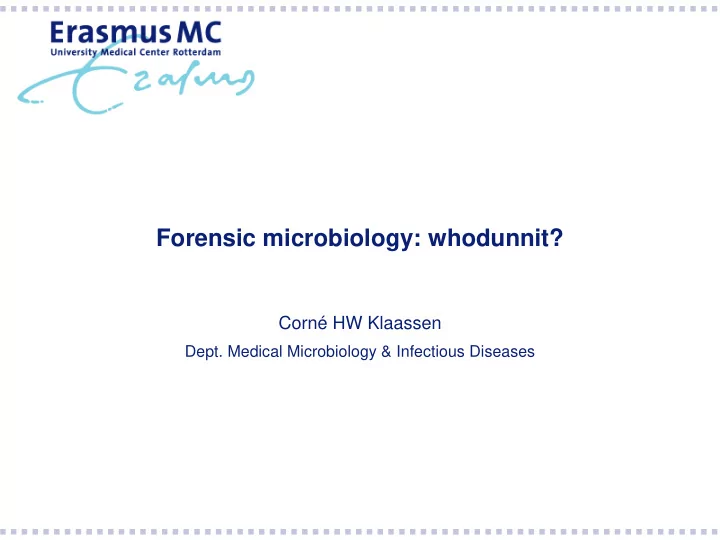

Forensic microbiology: whodunnit? Corné HW Klaassen Dept. Medical Microbiology & Infectious Diseases
Core activities MMIZ molecular diagnostics Detection Identification, Typing of potentially pathogenic micro-organisms Bacteria, fungi/yeasts, parasites using molecular (DNA/RNA) based techniques
Typing: a working definition The ability to discriminate between different ‘individuals’ of the same species Damn! Now your footprint will discrminate you Shoot! A from the rest of us! hole in my shoe! Not to confuse with ‘identification’: to determine to which species a micro-organism belongs.
Micro-organisms are easily spread person to person contact! surfaces, air, water animals (medical) devices (e.g. humidifiers, sterilization equipment) food, drinks contact lens fluids etc.
Rationale for typing Clonal expansion or different ‘individuals’ of the same species? Essential in potential outbreak scenario’s! HAI impose a significant economical burden! Efficacy of treatment / recurring infections? Monitoring local, national or global spread of specific ‘clones’
Molecular fingerprinting methods ‘Old’ school (not in use anymore): MLEE (multilocus enzyme electrophoresis) PFGE (pulsed field gelelectrophoresis) RAPD (random amplified polymorphic DNA) AP-PCR (arbitrarily primed PCR) ‘New’ school: AFLP (amplified fragment length electrophoresis) VNTR (variable number of tandem repeats) Microsatellites / Short tandem repeats MLVA (multilocus VNTR analysis) MLST (multilocus sequence typing) WGS (whole genome sequencing)
Basic characteristics of typing methods discriminatory power typeability reproducibility speed costs ease of use data interpretation, complexity need for a (pure) culture, application directly on clinical specimens genome coverage species specific vs. generic storage and exchange of data between labs
Amplified Fragment Length P olymorphism )
AFLP example: Aspergillus fumigatus No prior sequence information neccessary!
Multilocus sequence typing: MLST
Multilocus sequence typing: MLST Usually 7 markers are used
MLST for S. aureus Ruimy et al. JB, 2008
Microsatellites: principle
Microsatellites: multiplex option
MLVA / VNTR / microsatellites Schouls et al., PLoS One, 2009
Whole genome / Next generation sequencing: De Been et al. JCM, 2015
Whole genome / Next generation sequencing: Provides superior resolution compared to any other available genotyping method The ultimate genotyping / identification / characterization tool (???) Currently still too expensive and slow for routine use Different challenges with respect to data analysis and interpretation With a whole genome, you already have all answers, the questions will come later ….
Hospital acquired infection? Hey neighbour: Don’t what appears know: to be your same as problem? yours? Acinetobacter Acinetobacter baumannii baumannii
Hospital acquired infection? AFLP: indistinguishable genomes Possible transmission or exposure to same source Acinetobacter Acinetobacter baumannii baumannii
Hospital acquired infection? Hey neighbour: Don’t what appears know: to be your same as problem? yours? Enterococcus faecium Enterococcus faecium Vancomycin R Vancomycin R
Hospital acquired infection? MLST: indistinguishable genomes but … Enterococcus faecium Enterococcus faecium Vancomycin R Vancomycin R
Hospital acquired infection? Strain carries Strain carries ‘vanB’ gene ‘vanA’ gene No transmission! Enterococcus faecium Enterococcus faecium Vancomycin R Vancomycin R
Hospital acquired infection? Hey neighbour: Don’t what appears know: to be your same as problem? yours? Klebsiella pneumoniae ESBL Klebsiella pneumoniae ESBL blaCTX-M pos blaCTX-M pos
Hospital acquired infection? Sanger sequencing: Strain carries Strain carries ‘CTX-M-15’ gene ‘CTX-M-2 gene No transmission! Klebsiella pneumoniae ESBL Klebsiella pneumoniae ESBL blaCTX-M pos blaCTX-M pos
Hospital acquired infection? Hey neighbour: Don’t what appears know: to be your same as problem? yours? Pseudomonas aeruginosa Pseudomonas aeruginosa carbapenemase R (blaVIM-2) carbapenemase R (blaVIM-2)
Hospital acquired infection? blaVIM-2 blaVIM-2 on chromosome on plasmid! No transmission! Pseudomonas aeruginosa Pseudomonas aeruginosa carbapenemase R (blaVIM-2) carbapenemase R (blaVIM-2)
Hospital acquired infection? blaVIM-2 blaVIM-2 on plasmid on plasmid Possible transmission of plasmid! More likely to occur in the environment than between patients Pseudomonas putida Pseudomonas aeruginosa carbapenemase R (blaVIM-2) carbapenemase R (blaVIM-2)
Parameters used to reveal possible transmission of potentially dangerous micro-organisms may include analysis of the Genomic background (chromosome) Mobile elements (plasmids, integrons etc.) Individual genes (usually resistance genes) …. using a wide variety of molecular methods
Recommend
More recommend